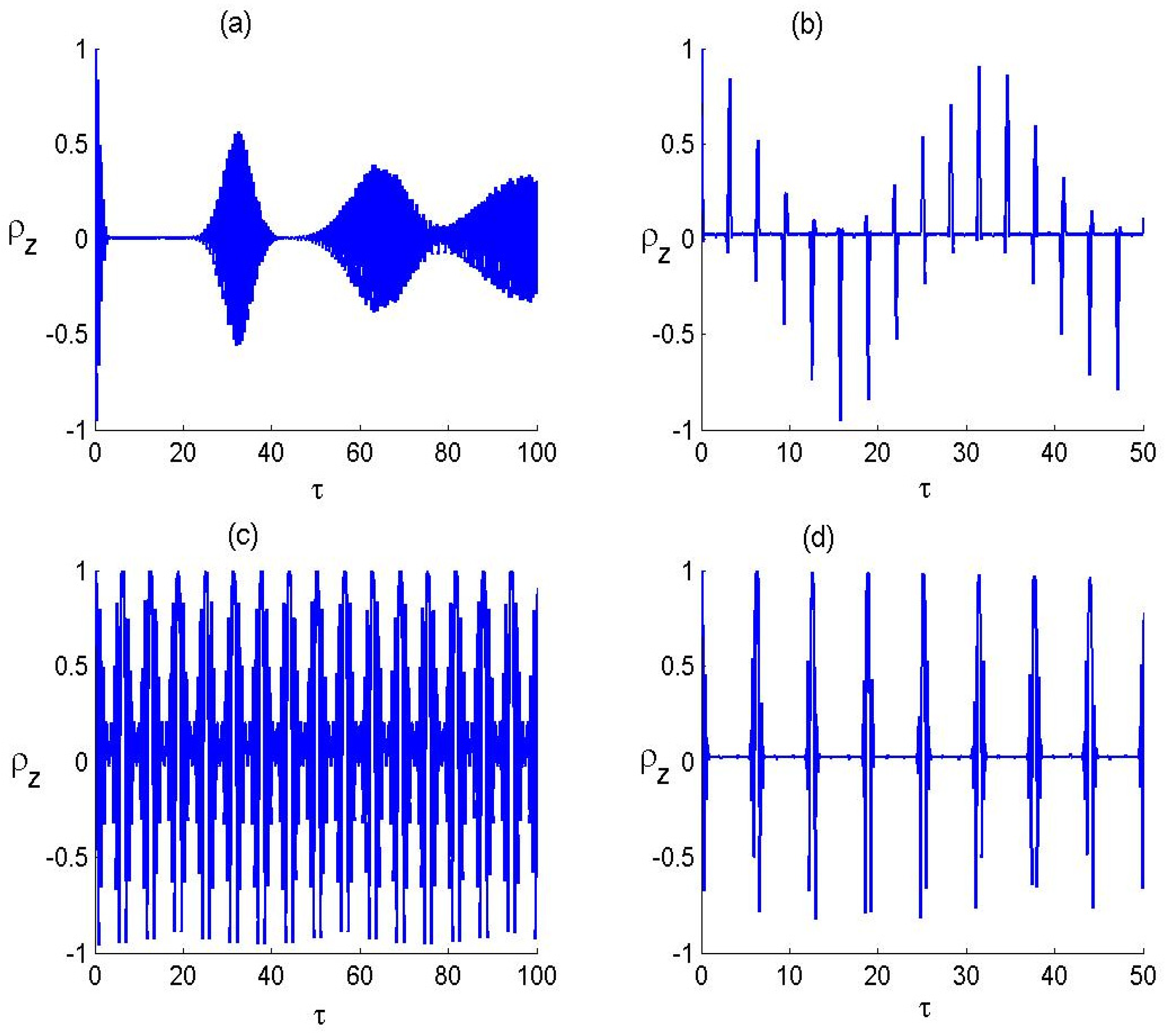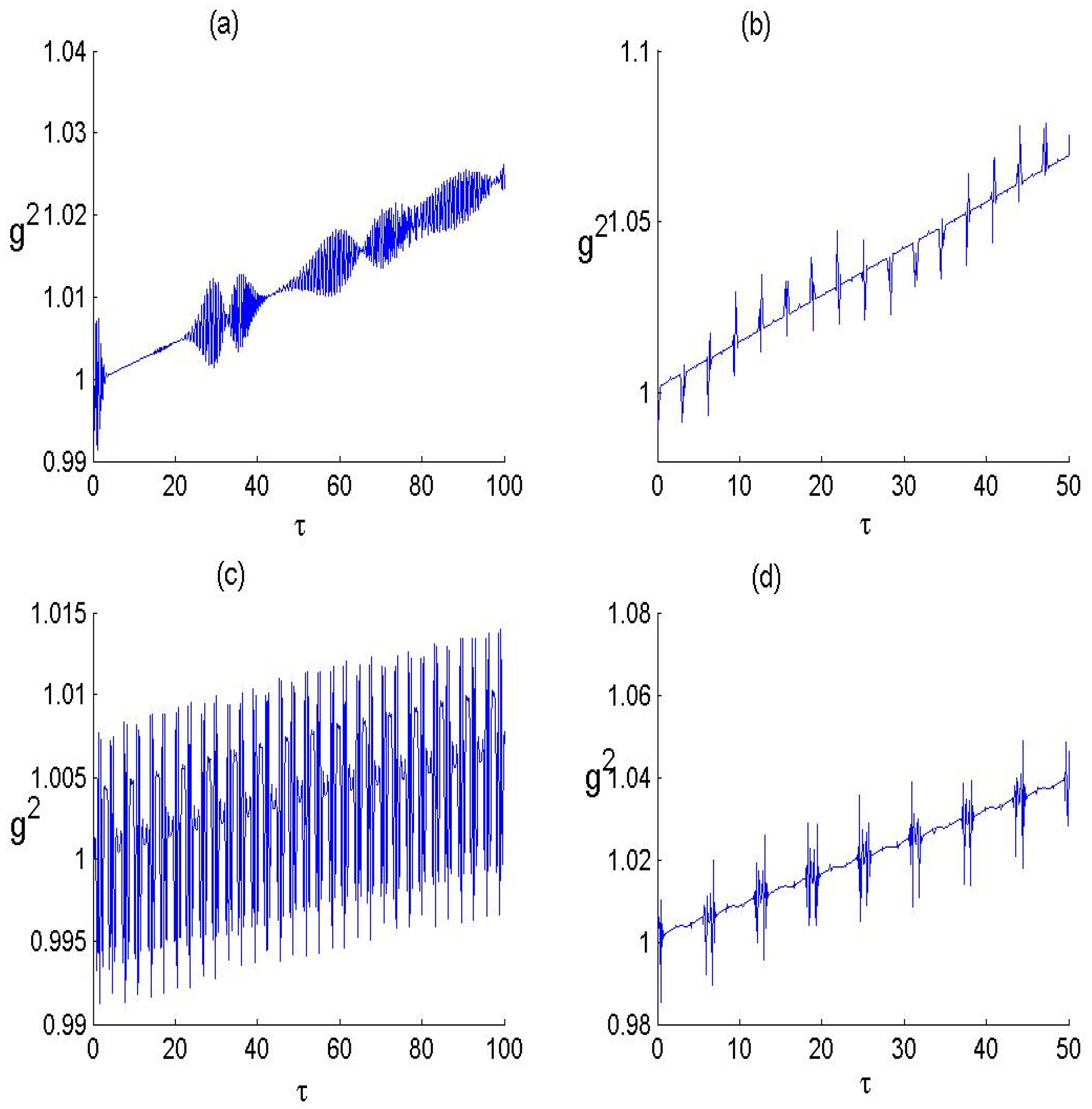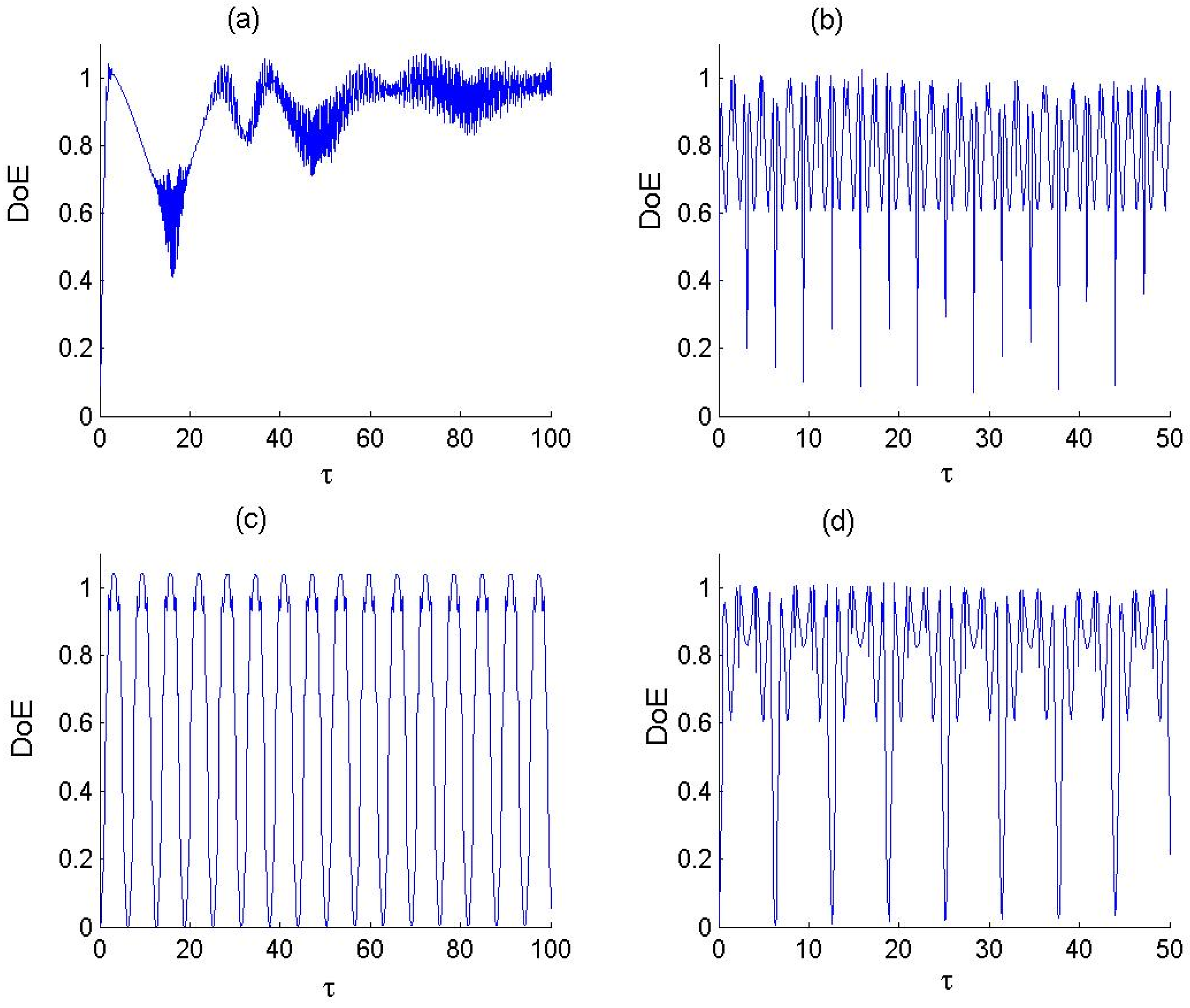Interaction of a Four-Level Atom with a Deformed Quantum Field: Mathematical Model and Quantum Resources
Abstract
1. Introduction
2. Mathematical Model and Dynamics
3. Quantum Quantifiers
3.1. Population Inversion Corresponding to the F-LA
3.2. Nonclassical Effects
3.3. Quantum Entanglement
3.4. Quantum Coherence
4. Numerical Results and Discussion
5. Conclusions
Author Contributions
Funding
Data Availability Statement
Acknowledgments
Conflicts of Interest
Appendix A. Detailed Calculation
References
- Arik, M.; Coon, D.D. Hilbert spaces of analytic functions and generalized coherent states. J. Math. Phys. 1976, 17, 524. [Google Scholar] [CrossRef]
- Biedenharn, L.C. The quantum group SUq (2) and a q-analogue of the boson operators. J. Phys. A Math. Gen. 1989, 22, L873. [Google Scholar] [CrossRef]
- Macfarlane, A.J. On q-analogues of the quantum Harmonic oscillator and the quantum group SU (2). J. Phys. A Math. Gen. 1989, 22, 4581. [Google Scholar] [CrossRef]
- Fakhri, H.; Nouraddini, M. Right SUq (2)- and left SUq−1 (2)-invariances of the q-Hilbert–Schmidt scalar products for an adjoint representation of the quantum algebra Ŭq (su2). J. Geom. Phys. 2016, 110, 90. [Google Scholar] [CrossRef]
- Fakhri, H.; Hashemi, A. Nonclassical properties of the q-coherent and q-cat states of the Biedenharn–Macfarlane q oscillator with q > 1. Phys. Rev. A 2016, 93, 013802. [Google Scholar] [CrossRef]
- Fakhri, H.; Sayyah-Fard, M. Arik-Coon q-oscillator cat states on the noncommutative complex plane and their nonclassical properties. Int. J. Geom. Meth. Mod. Phys. 2017, 14, 1750060. [Google Scholar] [CrossRef]
- Fakhri, H.; Sayyah-Fard, M. Nonclassical properties of the Arik-Coon q−1-oscillator coherent states on the noncommutative complex plane Cq. Int. J. Geom. Meth. Mod. Phys. 2017, 14, 1750165. [Google Scholar] [CrossRef]
- Fakhri, H.; Sayyah-Fard, M. q-coherent states associated with the noncommutative complex plane C q2 for the Biedenharn–Mac-farlane q-oscillator. Ann. Phys. 2017, 387, 14. [Google Scholar] [CrossRef]
- Fakhri, H.; Sayyah-Fard, M. Triplet q-cat states of the Biedenharn–Macfarlane q-oscillator with q > 1. Quantum Inf. Process. 2020, 19, 19. [Google Scholar] [CrossRef]
- Fakhri, H.; Mousavi-Gharalari, S.E. Nonclassical properties of two families of q-coherent states in the Fock representation space of q-oscillator algebra. Eur. Phys. J. Plus 2020, 135, 253. [Google Scholar] [CrossRef]
- Fakhri, H.; Sayyah-Fard, M. Noncommutative photon-added squeezed vacuum states. Mod. Phys. Let. A 2020, 35, 2050167. [Google Scholar] [CrossRef]
- Sayyah-Fard, M. Nonclassicality of photon-added q-squeezed first excited states. Phys. A 2021, 567, 125636. [Google Scholar] [CrossRef]
- Plyushchay, M.S. Deformed Heisenberg algebra with reflection. Nucl. Phys. B 1997, 491, 619. [Google Scholar] [CrossRef]
- Wigner, E.P. Do the equations of motion determine the quantum mechanical commutation relations? Phys. Rev. 1950, 77, 711. [Google Scholar] [CrossRef]
- Green, H.S. A generalized method of field quantization. Phys. Rev. 1953, 90, 270. [Google Scholar] [CrossRef]
- Jaynes, E.T.; Cummings, F.W. Comparison of quantum and semiclassical radiation theories with application to the beam maser. Proc. IEEE 1963, 51, 89–109. [Google Scholar] [CrossRef]
- Abdel-Aty, M. General formalism of interaction of a two-level atom with cavity field in arbitrary forms of nonlinearities. Phys. A 2002, 313, 471. [Google Scholar] [CrossRef]
- Baghshahi, H.R.; Tavassoly, M.K. Entanglement, quantum statistics and squeezing of two Ξ-type three-level atoms interacting nonlinearly with a single-mode field. Phys. Scr. 2014, 89, 075101. [Google Scholar] [CrossRef]
- Feneuile, S. Interaction of laser radiation with free atoms. Rep. Prog. Phys. 1977, 40, 1257. [Google Scholar] [CrossRef]
- Li, X.-S.; Lin, D.L.; Gong, C.D. Nonresonant interaction of a three-level atom with cavity fields. I. General formalism and level occupation probabilities. Phys. Rev. A 1987, 36, 5209. [Google Scholar] [CrossRef]
- Liu, Z.-D.; Li, X.-S.; Lin, D.L. Nonresonant interaction of a three-level atom with cavity fields. II. Coherent properties of the stimulated fields. Phys. Rev. A 1987, 36, 5220. [Google Scholar] [CrossRef]
- Abdel-Wahab, N.H. The general formalism for a three-level atom interacting with a two-mode cavity field. Phys. Scr. 2007, 76, 233. [Google Scholar] [CrossRef]
- Abdel-Wahab, N.H. A three-level atom interacting with a single mode cavity field: Different configurations. Phys. Scr. 2007, 76, 244. [Google Scholar] [CrossRef]
- Yurke, B.; Stoler, D. One-step synthesis of multiatom Greenberger-Horne-Zeilinger states. Phys. Rev. Lett. 1993, 57, 13. [Google Scholar] [CrossRef] [PubMed]
- Wang, H.; Goorskey, D.; Xiao, M. Dependence of enhanced Kerr nonlinearity on coupling power in a three-level atomic system. Opt. Lett. 2002, 27, 258–260. [Google Scholar] [CrossRef]
- Baghshahi, H.R.; Tavassoly, M.K. Dynamics of different entanglement measures of two three-level atoms interacting nonlinearly with a single-mode field. Eur. Phys. J. Plus 2015, 130, 37. [Google Scholar] [CrossRef]
- Liu, Z.D.; Zhu, S.-Y.; Li, X.-S. The properties of a light field interacting with a four-level atom. J. Mod. Opt. 1988, 45, 833. [Google Scholar] [CrossRef]
- Vaglica, A.; Vetri, G. Irreversible decay of nonlocal entanglement via a reservoir of a single degree of freedom. Phys. Rev. A 2007, 75, 062120. [Google Scholar] [CrossRef]
- Ficek, Z.; Tanas, R. Dark periods and revivals of entanglement in a two-qubit system. Phys. Rev. A 2006, 74, 024304. [Google Scholar] [CrossRef]
- Vitali, D.; Gigan, S.; Ferreira, A.; Böhm, H.R.; Tombesi, P.; Guerreiro, A.; Vedral, V.; Zeilinger, A.; Aspelmeyer, M. Optomechanical entanglement between a movable mirror and a cavity field. Phys. Rev. Lett. 2007, 98, 030405. [Google Scholar] [CrossRef]
- Zhang, Q.; Zhang, E.Y. Optimum parameters for biased two-state quantum key distribution protocol. Acta Phys. Sin. 2002, 51, 1684. [Google Scholar]
- Moller, C. Dissipative Rabi model in the dispersive regime. Phys. Rev. Res. 2020, 2, 033046. [Google Scholar] [CrossRef]
- Bennett, C.H.; Brassard, G.; Crépeau, C.; Jozsa, R.; Peres, A.; Wootters, W.K. Teleporting an unknown quantum state via dual classical and Einstein-Podolsky-Rosen channels. Phys. Rev. Lett. 1993, 70, 1895. [Google Scholar] [CrossRef] [PubMed]
- Metwally, N.; Abdelaty, M.; Obada, A.-S.F. Quantum teleportation via entangled states generated by the Jaynes–Cummings model. Chaos Solitons Fractals 2004, 22, 529. [Google Scholar] [CrossRef]
- Ekert, A.K. Quantum cryptography based on Bell’s theorem. Phys. Rev. Lett. 1991, 67, 661. [Google Scholar] [CrossRef]
- Bennett, C.H.; Wiesner, S.J. Communication via one-and two-particle operators on Einstein-Podolsky-Rosen states. Phys. Rev. Lett. 1992, 69, 2881. [Google Scholar] [CrossRef]
- Yang, M.; Song, W.; Cao, Z.L. Entanglement swapping without joint measurement. Phys. Rev. A 2005, 71, 034312. [Google Scholar] [CrossRef]
- Nielsen, M.A.; Chuang, I.L. Quantum Computation and Quantum Information; Cambridge University Press: Cambridge, UK, 2000. [Google Scholar]
- Bennett, C.H.; Shor, P.W.; Smolin, J.A.; Thapliyal, A.V. Entanglement-assisted classical capacity of noisy quantum channels. Phys. Rev. Lett. 1999, 83, 3081. [Google Scholar] [CrossRef]
- Phoenix, S.J.D.; Knight, P.L. Establishment of an entangled atom-field state in the Jaynes-Cummings model. Phys. Rev. A 1991, 44, 6023. [Google Scholar] [CrossRef]
- Phoenix, S.J.D.; Knight, P. Comment on “Collapse and revival of the state vector in the Jaynes-Cummings model: An example of state preparation by a quantum apparatus”. Phys. Rev. Lett. 1991, 66, 2833. [Google Scholar] [CrossRef]
- Baumgratz, T.; Cramer, M.; Plenio, M.B. Quantifying coherence. Phys. Rev. Lett. 2014, 113, 140401. [Google Scholar] [CrossRef]
- Berrada, K.; Algarni, M.; Marin, M.; Abdel-Khalek, S. Effects of Dipole-Dipole Interaction and Time-Dependent Coupling on the Evolution of Entanglement and Quantum Coherence for Superconducting Qubits in a Nonlinear Field System. Symmetry 2023, 15, 732. [Google Scholar] [CrossRef]
- Algarni, M.; Berrada, K.; Abdel-Khalek, S. Quantum coherence and parameter estimation for mixed entangled coherent states. Mod. Phys. Lett. A 2022, 37, 2250159. [Google Scholar] [CrossRef]
- Abdel-Khalek, S.; Algarni, M.; Marin, M.; Berrada, K. Entanglement, quantum coherence and quantum Fisher information of two qubit-field systems in the framework of photon-excited coherent states. Opt. Quant. Elect. 2023, 55, 1288. [Google Scholar] [CrossRef]
- Majid, S. Foundations of Quantum Group Theory; Cambridge University Press: Cambridge, UK, 1995. [Google Scholar]
- Madore, J. Noncommutative Geometry for Pedestrians. Phys. Rep. 1997, 282, 1. [Google Scholar]
- Snyder, H.S. Quantized Space-Time. Phys. Rev. 1947, 71, 38. [Google Scholar] [CrossRef]
- Freidel, L.; Livine, E.R. Ponzano-Regge model revisited III: Feynman diagrams and effective field theory. Class. Quantum Grav. 2006, 23, 2021. [Google Scholar] [CrossRef]
- Wen, X.-G. Quantum Field Theory of Many-Body Systems; Oxford University Press: Oxford, UK, 2004. [Google Scholar]
- Nayak, C.; Simon, S.H.; Stern, A.; Freedman, M.; Das Sarma, S. Non-Abelian anyons and topological quantum computation. Rev. Mod. Phys. 2008, 80, 1083. [Google Scholar] [CrossRef]
- Das Sarma, S.; Freedman, M.; Nayak, C. Topologically protected qubits from a possible non-Abelian fractional quantum Hall state. Phys. Rev. Lett. 2005, 94, 166802. [Google Scholar] [CrossRef]
- Read, N.; Rezayi, E. Beyond paired quantum Hall states: Parafermions and incompressible states in the first excited Landau level. Phys. Rev. B 1999, 59, 8084. [Google Scholar] [CrossRef]
- Moore, G.; Read, N. Nonabelions in the fractional quantum Hall effect. Nucl. Phys. B 1991, 360, 362. [Google Scholar] [CrossRef]
- Kitaev, A. Fault-tolerant quantum computation by anyons. Ann. Phys. 2003, 303, 2. [Google Scholar] [CrossRef]
- Wen, X.-G. Topological orders and edge excitations in fractional quantum Hall states. Adv. Phys. 1995, 44, 405. [Google Scholar] [CrossRef]
- Bernevig, B.A.; Hughes, T.L.; Zhang, S.C. Quantum spin Hall effect and topological phase transition in HgTe quantum wells. Science 2006, 314, 1757. [Google Scholar] [CrossRef]
- Hasan, M.Z.; Kane, C.L. Topological insulators. Rev. Mod. Phys. 2010, 82, 3045. [Google Scholar] [CrossRef]
- Kitaev, A. Periodic table for topological insulators and superconductors. AIP Conf. Proc. 2009, 1134, 22. [Google Scholar]
- Bennett, C.H.; Brassard, G. Quantum cryptography: Public key distribution and coin tossing. Theor. Comput. Sci. 2014, 560 Pt 1, 7–11. [Google Scholar] [CrossRef]
- Braunstein, S.L.; Caves, C.M. Statistical distance and the geometry of quantum states. Phys. Rev. Lett. 1994, 72, 3439. [Google Scholar] [CrossRef]
- Dowling, J.P.; Milburn, G.J. Quantum technology: The second quantum revolution. Phil. Trans. R. Soc. A 2003, 361, 1655. [Google Scholar] [CrossRef]
- Kimble, H.J. The quantum internet. Nature 2008, 453, 1023. [Google Scholar] [CrossRef]
- Clarke, J.; Wilhelm, F.K. Superconducting quantum bits. Nature 2008, 453, 1031. [Google Scholar] [CrossRef] [PubMed]
- Barends, R.; Kelly, J.; Megrant, A.; Veitia, A.; Sank, D.; Jeffrey, E.; White, T.C.; Mutus, J.; Fowler, A.G.; Campbell, B.; et al. Superconducting quantum circuits at the surface code threshold for fault tolerance. Nature 2014, 508, 500. [Google Scholar] [CrossRef] [PubMed]
- Haroche, S.; Raimond, J.-M. Exploring the Quantum: Atoms, Cavities, and Photons; Oxford University Press: Oxford, UK, 2006. [Google Scholar]
- Fakhri, H.; Sayyah-Fard, M. The Jaynes–Cummings model of a two-level atom in a single-mode para-Bose cavity field. Sci. Rep. 2021, 11, 22861. [Google Scholar] [CrossRef] [PubMed]




Disclaimer/Publisher’s Note: The statements, opinions and data contained in all publications are solely those of the individual author(s) and contributor(s) and not of MDPI and/or the editor(s). MDPI and/or the editor(s) disclaim responsibility for any injury to people or property resulting from any ideas, methods, instructions or products referred to in the content. |
© 2025 by the authors. Licensee MDPI, Basel, Switzerland. This article is an open access article distributed under the terms and conditions of the Creative Commons Attribution (CC BY) license (https://creativecommons.org/licenses/by/4.0/).
Share and Cite
Algarni, M.; Abdel-Khalek, S.; Berrada, K. Interaction of a Four-Level Atom with a Deformed Quantum Field: Mathematical Model and Quantum Resources. Axioms 2025, 14, 211. https://doi.org/10.3390/axioms14030211
Algarni M, Abdel-Khalek S, Berrada K. Interaction of a Four-Level Atom with a Deformed Quantum Field: Mathematical Model and Quantum Resources. Axioms. 2025; 14(3):211. https://doi.org/10.3390/axioms14030211
Chicago/Turabian StyleAlgarni, Mariam, Sayed Abdel-Khalek, and Kamal Berrada. 2025. "Interaction of a Four-Level Atom with a Deformed Quantum Field: Mathematical Model and Quantum Resources" Axioms 14, no. 3: 211. https://doi.org/10.3390/axioms14030211
APA StyleAlgarni, M., Abdel-Khalek, S., & Berrada, K. (2025). Interaction of a Four-Level Atom with a Deformed Quantum Field: Mathematical Model and Quantum Resources. Axioms, 14(3), 211. https://doi.org/10.3390/axioms14030211





